



Bloody Scours (Swine Dysentery): a Costly Re-emerging Disease That is Preventable
Clinical signs and control of swine dysentery are described by Dr Jim McKean, Dr Eric Burrough and Dr Ken Schwartz of Iowa State University. In this factsheet for Pork Information Gateway, they estimate the annual cost of this disease to the US pig industry to be around $200 million.Scope of Issue

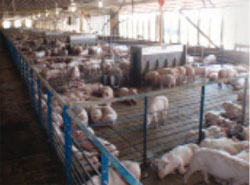
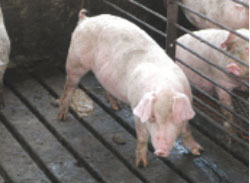
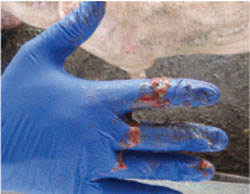
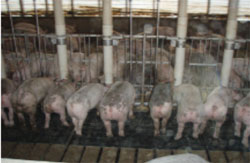
In the past few years, an expensive swine disease that had largely disappeared has begun to re-emerge in a few Eastern and Midwestern as well as Canadian swine operations. Swine dysentery (SD or bloody scours) is a “gut” disease which is very expensive to treat medically and difficult to effectively remove once pigs and facilities are contaminated.
SD is carried by infected swine, other animals in contact with infected swine, as well as small amounts of manure adhered to equipment or clothing. Biosecurity steps that can reduce these exposure risks, and protect your facilities and investments should be immediately implemented to slow the spread of this disease.
Your swine veterinarian can assist you in diagnostics and biosecurity plan formulation to protect your herd.
Objectives
- Increase threat awareness of bloody scours in your herd
- Review key disease concepts including transmission and methods for control
- Provide a guide to clinical signs to indicate potential infections
- Describe prevention steps to limit introduction into your herd
- Provide resources for gathering additional information
Historical Perspective
Long before PRRS, swine dysentery was the major “profit robber” disease for swine producers. Between 1970 and 1990, swine dysentery cost the US swine industry at least $64 million yearly. Swine dysentery was present in over one-third of Iowa swine herds and remains widespread globally.
The disease virtually disappeared from the US during the 1980s and 1990s because of a better understanding of cause and transmission, availability of SD-free breeding stock, better biosecurity/sanitation, and availability of cost-effective treatment/elimination drugs for use in a herd eradication program. Bloody scours was believed to be a problem of the past, however it has been re-emerging in North America since 2005. Increased frequency of SD has occurred with infected imported pigs moving to Iowa for finishing.
Currently, 32 to 33 per cent of US market hogs are finished in Iowa and 75 per cent of those pigs originate from outside of Iowa. Trailers or buying stations and packing plants that are contaminated by infected pigs are sources of infection. Trailers and equipment will remain infective until effective trailer clean-up and disinfection.
Current Situation
Swine dysentery cases have increased since 2005 (data from the Iowa State University veterinary diagnostic Laboratory).
The cause of swine dysentery was identified in 1971 as a new bacteria - Treponema hyodysenteriae (subsequent name changes included: Serpula, Serpulina and currently Brachyspira). After the discovery of this organism, better understanding of its transmission and environmental susceptibility led to new treatment, control, prevention and elimination strategies. Successful veterinary elimination strategies caused SD to virtually disappear from Iowa farms during the 1980s and 1990s. However, the disease appears to have been suppressed and not eradicated in some locations and is now re-emerging.
The frequency of Brachyspira hyodysenteriae (B. hyo) detection in grow-finish diarrhea cases has risen. In 2005, three B. hyo positive cases were presented to the Iowa State University Veterinary Diagnostic Laboratory (ISU VDL) and this number has increased to 84 cases in 2010.
How to recognise the clinical signs of swine dysentery
- Soft to watery faeces are common first signs
- Diarrhoea, usually with mucus and/or blood as signs progress
- Uneven pig growth, increased mortality, and significantly reduced feed efficiency are seen as disease progresses
- Laboratory testing is needed to differentiate swine dysentery from other diarrhoeas
Swine dysentery causes diarrhoea with variations in colour (gray-yellow-red), consistency and composition; faeces often contain mucus or blood. An accurate diagnosis cannot be established by only looking at faeces. Focus on faeces appearance may lead to a misdiagnosis as salmonellosis, ileitis and SD can all appear similar at various stages. Your swine veterinarian can assist in an accurate determination of diarrhoea causation in your herd.
Signs of SD are first seen in a few pigs seven to 14 days after initial infection as soft, yellow-to-grey faeces. Variations within signs from a low-grade diarrhoea to obvious SD clinical disease may be seen. The clinical signs may spread slowly within a barn, or rapidly depending on the causative organism and exposure dosage. Groups of pigs will grow unevenly leading to variation in weights within or between pens. Variation in growth may not be easily recognised but is a costly consequence of infection.
As SD progresses, mucus, flecks of whitish fibrin and variable amounts of blood are found in the “puddling” or watery faeces.
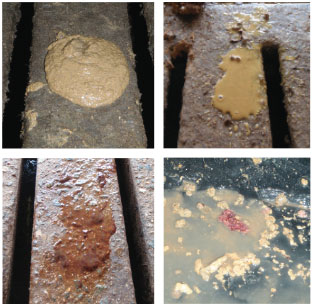
Animals with swine dysentery will have intermittent diarrhoea, dehydration, lose body condition and will have reduced growth rate. Diarrhoea staining may appear around and below the rectum. If left without effective treatment, deaths can/will occur.

Careful observation is required to identify potential SD infections. A veterinarian may evaluate clinical signs and gross lesions to reach a suggestive diagnosis. Since clinical signs are similar for many infections including other Brachyspira sp., Salmonella, proliferative ileitis (Lawsonia) whipworms and gastric ulcers, additional testing may be required to obtain a definitive diagnosis. Frequently, she/he must rely on laboratory testing, particularly for Brachyspira infections including SD, to confirm a clinical diagnosis.
Tips for identifying the signs of Swine Dysentery - if you see any of these signs, investigate!
- Walk pens first thing in the morning when pigs are more active and before manure is pushed through the slats.
- Look for individually affected pigs:
- gaunt pigs
- faecal staining below the rectum
- blood or red staining on pigs or in manure
- Look at floor for fresh feces for the following: consistency, colour and composition characteristics.
| Table 1: Diarrhoea and the '3 Cs' of swine dysentery | |||
|---|---|---|---|
| Consistency: | Porridge-like/ “puddling" | Fluid | Watery |
| Colour: | Grey | Yellowish, Greenish-yellow | Dark or bright red |
| Composition: | Mucus Moist and glistening Egg-white appearance Dry mucus particles |
Bloody Fresh blood, in small flecks Blood mixed with mucus Blood mixed uniformly with faeces |
Fibrinous White or tan “strings” Pieces of sloughed tissue Specks of sloughed tissue |
- Abnormal feaces should be investigated by a veterinarian. Based on clinical signs, your veterinarian may make a diagnosis or may need to investigate further. Necropsy and/or laboratory testing may be required to determine the cause.
Swine Dysentery (bloody scours) – diagnostic considerations:
- Swine dysentery is an emerging diagnostic consideration in grow-finish diarrhoeas
- There are other species of Brachyspira bacteria that can cause grow-finish diarrhoea and colitis
- There are non- Brachyspira causes of grow-finish diarrhoea and colitis
- Diagnosis requires veterinary involvement
- Accurate differential diagnosis requires necropsy and/or laboratory testing
Since SD clinical signs resemble those of other Brachyspira infections — Salmonella, proliferative enteritis (ileitis/Lawsonia), PCV2, whipworms, gastric ulcers, and dietary sensitivities — it is important to investigate the cause of pigs with clinical diarrhea. Accurate diagnosis helps assure that appropriate treatment and control strategies are implemented. Veterinarians trained in disease diagnosis, disease prevention and control provide valuable information about causes and solutions to the production team.
Transmission
- Infected pigs and their feces are primary sources of infection
- Manure storage and handling equipment are long-term sources of infection
- Fecal contamination of fomites (transport vehicles, handling equipment, tools, boots, etc.) can transfer infection to new locations
- Mice can carry B. hyo for a year after infected pigs are removed
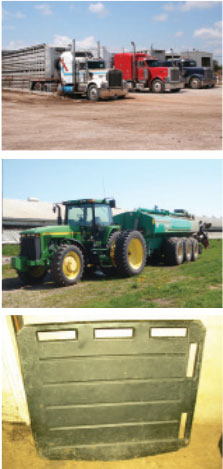
An important characteristic of SD is the ability to survive in faeces- contaminated environments for long periods of time (Table 2). In general, Brachyspira survive well in moist, cool faeces or organic material or attached to inanimate objects (fomites). This means that any surface contaminated with swine faeces can be a potent source of infection to previously unaffected populations.
A pig affected with bloody scours can shed hundreds of billions of organisms per day. It is estimated that only 100 organisms are sufficient to infect a pig and cause clinical SD. One teaspoon of contaminated faeces contains enough organisms to infect an entire herd.
SD can be spread mechanically by movement of manure-contaminated fomites. Fomites include boots, clothing, transport vehicles, farm equipment, tools, manure disposal equipment – anything that can be contaminated with swine feces. Frequent sanitation of equipment, clothing and transport vehicles will minimize the risk of an SD outbreak.
Infected pigs carry, shed and transmit Brachyspira, making them the primary carriers of SD. Given current testing limitations, assume all new stock introduced is potentially exposed/infected. Health history of new sources should be investigated prior to placement of feeder or breeding stock to prevent facility contamination. Breeding stock should be quarantined without exposure to antibiotics for at least 30 days before entering the herd.
Removal of antibiotics allows disease signs to be expressed in two to four weeks if a group is infected. During the quarantine period, daily observation for clinical signs should be performed. Available antibiotics in the feed or water can suppress symptoms of disease, but will not by themselves eliminate the infection under most conditions.
Not only does one need to consider the movement of faecal material within a farm, but also between farms. Trucks and vehicles that are traveling between farms or markets (marketing, manure disposal, service vehicles) may introduce SD into a previously healthy herd.
Appropriate biosecurity assures that practices and procedures are in place to prevent the introduction of disease to a herd or production site. With SD, limiting swine exposure to any outside source of pig manure is essential. Rodents, specifically mice, can carry the bacteria for up to a year. A strong rodent control program should be established. Farm cats, dogs and birds are potential short-term carriers of this organism. Swine barns should be constructed to prevent entry of dogs, cats, birds and other wildlife.
The organism can survive in manure, including lagoon water, for extended periods. Exposure to previously infected manure puts the entire herd at risk for infection.
| Table 2. Survival of Brachyspira hyodysenteriae in different conditions | |||
|---|---|---|---|
| Location | Condition | Temperature (°F) | Survival time |
| Animal carriers | |||
| Mice | - | - | 1 year |
| Rats | - | - | 2 days |
| Dogs | - | - | 13 days |
| Birds | - | - | 21 days |
| Pigs | - | - | Indefinitely |
| Faeces | |||
| Pits | Moist | 45 | 60+ days |
| Hog lots | Sun-dried manure | 65 | 7 days |
| Hog lots | Cold or frozen | 45 | Until temperature increases |
| Lagoons | - | - | 60+ days |
Financial Impact
- $115 million loss to the US swine industry in 1991= $169-$236 million today
- $7-9 for medication per affected pig in 1990 = $11.70-17.50 today
In 1994, it was estimated that the total financial cost of swine dysentery in the US alone was approximately $115.2 million. This value, depending on the conversion factors used, would represent from $169-$236 million today. Substantial costs are accrued because of slower growth, decreased feed efficiency, increased mortality and the cost of prolonged antibiotic use. In 1990, it was estimated that it cost $8.30 to medicate each SD-positive pig to market. That figure equals $11.70 to $17.50 today.
Control Measures
- Treatment and control relies on use of effective medications
- Elimination by partial depopulation, medicate-clean-move protocols, or depopulation-repopulation was fairly successful
- As site population size increases, elimination becomes more difficult with coordination of medication, animal movement and environmental clean-up necessary to eliminate SD
- Your veterinarian can be a valuable resource in developing an appropriate control or eradication plan
Depopulation of an entire herd followed by repopulation (“depop/repop”) and SPF (specific pathogen free) programmes coupled with extensive facility cleaning were successful in eliminating infections in the 1960 and 1970s but were very costly options.
The identification of the causative bacteria in 1971 offered opportunities for development of alternative control/ elimination methods through better understanding of pathogen spread and antibiotic sensitivity. Several economical antibiotics were found to eliminate B. hyo in manure while being fed. Partial depopulation with repeated cycles of prolonged medication, cleaning and disinfection, and moving groups of pigs to a clean environment was implemented successfully. Unfortunately, these antibiotics are no longer available for animal use. Other antibiotics, useful for treatment to control SD symptoms, were unable to eliminate B hyo. from the pig or the environment. Their continued use added considerable cost to production because of prolonged and high levels of feed inclusion.
Strategically important today, over 20 antimicrobials have been used for treatment and control of SD over the last 60 years. Many are no longer available in the US. Several that remain available have lost effectiveness. The cost of SD treatment is high and likely to be economically unsustainable long term. Because of the cost and the limited treatment options available, the best approach is prevention based on a properly formulated biosecurity plan.
Your veterinarian can assist you in diagnosis, proper treatment selection and methods of control or eradication of SD. Of greater importance, your veterinarian can assist with prevention planning. Since SD is expensive to treat and control, and is currently at low incidence levels in Iowa, it is of paramount importance to focus on disease prevention in your operation now.
Prevention: If you don’t have SD, don’t drag it home!
- Isolate all incoming breeding stock for 30 days without antibiotics and examine for clinical signs
- Biosecurity protocols should be developed in consultation with your swine veterinarian
- Biosecurity protocols should be implemented for all personnel in potential contact with pigs
- Isolate your production facility from visitors and off-farm vehicles
- Feed trucks, rendering trucks, service vehicles kept away from swine areas of site
- All visitors follow strict established biosecurity protocols
- All vehicles hauling pigs are cleaned, disinfected and dried prior to use
- All footwear and clothing exposed to off-site swine or manure should be changed before entry (Boots or footwear worn in other swine locations should be changed before entry)
- Decontaminate all possible fomites such as boots, clothing and pig handling equipment
- Clean and disinfect load-out area immediately after use
- Bird-proof facilities to keep out birds, wildlife and other animals to reduce farm-to-farm exposure
- Aggressively suppress rodents and insects in the facilities to reduce exposure
Elimination: Have a written plan and follow it!
Any attempt to eliminate SD from a site or herd will require dedicated commitment of the entire production staff. A comprehensive, written site-specific plan of action must be developed and followed.
Your veterinarian can provide specific recommendations tailored to your production, current B. hyo elimination strategies and animal movement considerations.
Key components include:
- Attempt elimination only during the warm months
- Certain medications may eliminate B. hyo shedding, hence the sequence of medicate-move-medicate-move has been useful on some farms. Essentially, pigs are medicated while aggressively removing faeces from their environment, pigs are moved to clean, segregated premises while continuing medication (often repeatedly)
- Removal of all faeces and organic matter is essential for elimination; soap and disinfectants are used to clean facilities to remove the bacteria from the environment
- Aggressively control mice, rodents, birds and wildlife access to swine and swine facilities:
- Feces from infected mice are a source of B. hyo indefinitely.
- Eliminate mouse populations and mouse faeces
- Treat remaining mouse populations with an SD-effective medication in feed before pigs are allowed back into the space
- Medication and early weaning (MEW) to an off-site nursery can be used to help break the cycle of infection from sows to piglets, but requires proper drug selection, timing and dosages to be effective
- “Flush” manure systems should plan to use only fresh water indefinitely
- Manure storage areas and transport vehicles are potential sources of infection. Consult your veterinarian for specific recommendations based on your particular farm exposure.
July 2013








